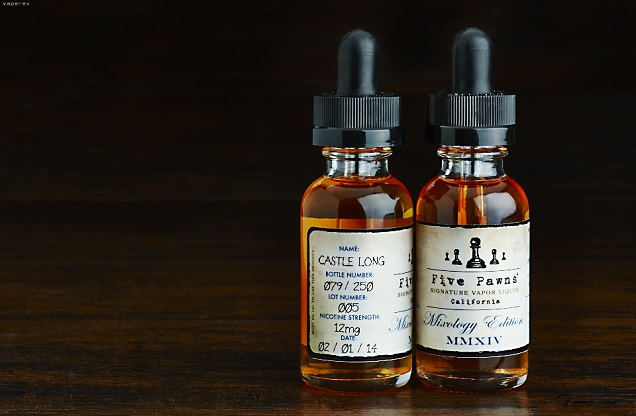
The recent revelation that Five Pawns’ extremely expensive e-liquid may be riddled with diacetyl (DA) and acetyl propionyl (AP) brings an important issue to the light once again: the flavorings we inhale might not be good for us. However, as with Vapor Shark’s recent release of their results of testing on the juices they carry, there is some dispute as to whether the results are accurate, with different labs reporting wildly different findings on the same e-liquids. Five Pawns called the claims based on the results “fraudulent,” but their own testing doesn’t paint a much rosier picture of their juices. So, what’s the deal with DA and AP in e-liquid? Which are the worst offenders based on the tests available? And can we even trust the results?
TL;DR
- DA and AP are bad for you when inhaled. DA is linked to “popcorn lung disease” and AP – based on animal testing and the structural similarity – appears to be basically the same. In e-liquid, it’s an avoidable risk.
- Five Pawns, in response to test results, effectively said that we don’t definitely know they’re bad for you, repeated a common misconception and claimed there is no evidence that AP is harmful.
- Many e-liquid lab testing results for DA and AP have been disputed, including some on Suicide Bunny’s juices. The disputed figures all use GC-MS testing, whereas the ones showing lower amounts often use GC-FID.
- If GC-FID testing isn’t correctly calibrated, it can give erroneously low results for oxygen-containing molecules like DA and AP. I’m not an expert, admittedly, but this may explain the discrepancies and could suggest that GC-MS results are more reliable.
- Five Pawns’ disputed results put Absolute Pin as the highest-AP juice ever found, but even their own GC-MS testing puts Bowden's Mate within the top 10, based on the Suicide Bunny results, Dr. Farsalinos’ study and Vapor Shark’s testing.
Diacetyl and Acetyl Propionyl: the Basics
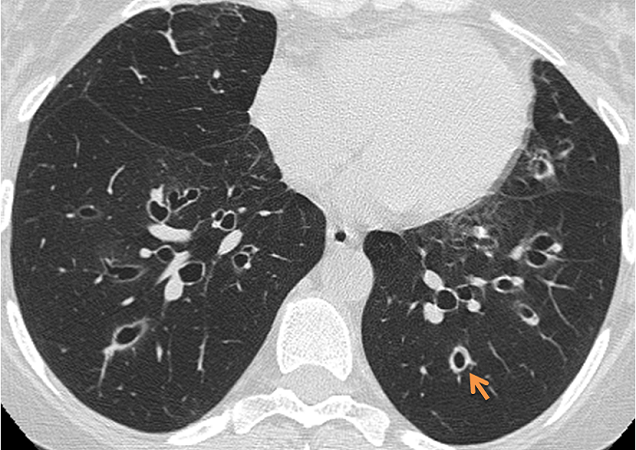
Diacetyl (DA) is a food flavoring you’ll likely come into contact with everyday, but it’s also been associated with lung problems when inhaled, in particular due to a condition called bronchiolitis obliterans or “popcorn lung disease.” The name comes from the fact that it was first observed in workers in a popcorn factory, although it’s also been observed in workers in a plant that manufactures the chemical. Although the link may not be definitive, with plenty of evidence in factory workers, toxicological and animal studies all pointing to the same problems from DA inhalation, there is plenty of reason to think that it shouldn’t be intentionally added to e-liquid.

Acetyl propionyl (AP) is an alternative to DA, but for all intents and purposes, it appears to be just as bad. It’s a very structurally similar chemical, and many animal studies have indicated that it has similar effects, so despite the lack of clear evidence in humans, the risks should be assumed to be pretty much identical.
The issue of DA and AP in e-liquid really gained some traction with the release of a study investigating its presence in e-liquid by Dr. Farsalinos and colleagues. Based on an analysis of 159 e-liquids and concentrated flavors expected to contain the chemicals, the study found that around 74 percent contained either DA or AP. The median daily exposure for vapers was calculated to be 56 μg (1 μg = 1 millionth of a gram) per day for DA and 91 μg per day for AP, which are 100 times and 10 times lower than the exposure for a smoker, respectively.
For comparison, the authors used recommendations from the National Institute for Occupation Safety and Health (NIOSH) to determine what could class as “acceptable” levels of the chemicals in e-liquid, calculating 65 μg for DA and 137 μg per day for AP. The median levels of exposure for vapers were lower than these, but there was a lot of variation, and many e-liquids expose users to higher than recommended levels. The authors rightfully called their presence in e-liquids an “avoidable risk.”
Five Pawns’ Response: Be (Mis)informed

Cloud 9’s results for Five Pawns have been removed from their website and replaced with a message stating they’re seeking legal advice. You see, Five Pawns went the legal route and issued them with a cease and desist, claiming that the testing was conducted using a non-validated method. Of course, you can’t keep anything hidden once it’s been posted online, and the results are fully available on Imgur for anybody not afraid of data. Whether they’re reliable is an issue, but the results as reported simply are what they are.
Absolute Pin, in particular, came in with 40 μg/ml of DA and an incredible 2,500 μg/ml of AP. In other words, according to the results, if you had 2 ml of the stuff you’d be over the recommended intake for DA and more than 36 times over the recommended daily limit for AP. It’s the highest result that’s ever been found in e-liquid.
Sadly, Five Pawns hasn’t dealt with this issue particularly well; now or in the past. They’ve previously claimed their e-liquid to be DA free, but the testing on their own website (the one they say is reliable) shows that Perpetual Check does contain DA. The AP levels are also pretty high across the board.
Their blog post in response to the finding contains too many half-truths for comfort. Firstly, they repeat this common argument: “It is important to note however, that high levels of both diacetyl and AP are present in cigarettes, yet there has been no link to bronchial obliterates” (i.e. popcorn lung).
This seems like a fair point, but unfortunately – as covered in Dr. Farsalinos’ study – it isn’t a valid one, since there is (obviously) more than one element in cigarette smoke that causes lung damage (which is why COPD is common in smokers), and the condition is often misdiagnosed. In simple terms: smokers probably do get it; it’s just hidden underneath all the other crap smoking does to you.
The other point they make, “While AP has not been linked to any health concerns, and it is not banned by the FDA or any international body, its relative safety or harm is unknown,” is, as we know from the earlier discussion, pretty much nonsense. It has been linked to health concerns, and although it’s technically not known whether it will cause similar lung disease in humans, it’s incredibly plausible to the point of being hard to deny. And the fact that it isn’t banned is meaningless for our, inhalation-specific purposes.
Finally, as if they hadn’t done enough to mislead their customers, they make the laughable statement: “one would expect a population of individuals becoming sick from vaping, but this is not the case. There are no known publicly documented cases of anyone having respiratory issues related to vaping AP or diacetyl at the levels currently in e-liquids.”
This is frankly idiotic. People probably haven’t been vaping for long enough to expect that – in one case, a man ate two bags of microwave popcorn a day for ten years before developing the condition, and the evidence from factory workers shows that things get worse over time. Perhaps we don’t have evidence of harm at the levels of exposure expected from vaping, but we don’t have much evidence at all at these levels, and we haven’t been vaping for very long, so we genuinely don’t know yet.
So, between trying to gloss over the problem with nonsense and threatening legal action because some testing doesn’t reflect well on your company, Five Pawns has hardly come out of this issue well.
Can We Trust E-Liquid Lab Test Results?
This question is pretty hard to answer. When Vapor Shark released their findings (from Enthalpy Analytical), Cyclops Vapor cried foul, claiming that their third-party tests gave different results. The Suicide Bunny saga followed much the same pattern: one test from Enthalpy showed high levels of AP in Mother’s Milk, but testing from another lab suggested that there was 40 times less than that. There are even claims that three bottles taken from the same batch sent to Enthalpy returned different results.
Now, I’m far from an analytical chemist, but it seems that there's a pattern within these disagreements. Firstly, Enthalpy Analytical uses gas chromatography mass spectrometry (GC-MS) for their testing, so the results from Vapor Shark and the original Mother’s Milk test showing high levels for some e-liquids (as in, more than the recommended daily limit in a single ml) both use this method. The Five Pawns tests conducted by Cloud 9 also used GC-MS testing.
But, the mixers all complained, “our tests gave different results.” The Suicide Bunny-commissioned testing used USP<467>, which appears to involve gas chromatography and flame ionization detection (GC-FID). Similarly, the lower results from Five Pawns’ commissioned testing used GC-FID where possible. Ceutical Labs (who conducted Cyclops Vapor’s tests) appears to use low thermal mass testing, but beyond that I can’t find too much information on their method (described only as “LTM-226-A”).
Five Pawns actually has two sets of results available: one using GC-MS and another using GC-FID (for most chemicals). Comparing these suggests that discrepancies can exist: Bowden’s Mate gave a result of 627.7 μg/ml when tested using GC-FID, but 910 μg/ml using GC-MS. Admittedly, though, the other results are relatively similar to one another. It appears – although this is far from certain (again, I’m really not an expert on this) – that the differences might have a lot to do with the testing protocols used.
FID, in particular, isn’t as responsive to ketones, an issue related to the presence of oxygen in the compound. DA and AP are ketones (diketones, more specifically) – containing two oxygen atoms per molecule – which could be very relevant to determining which results are more reliable.
The problem is that the response of the detector – the size of the peak on the readout, which is vital to working out the quantity of a given chemical in the sample – is reduced when there is more oxygen in the molecule. If the detector isn’t calibrated for the individual components (which, for other mixtures, it doesn’t need to be) this can lead to under-reporting of the oxygen-containing molecules, such as DA and AP. In other words: if the FID tests weren’t conducted properly, this could lead to lower readings for the amount of DA and AP in the e-liquid.
This is ultimately just speculation, though; I’m not an analytical chemist (and GC-MS readings can have issues too). However, it’s clear that in all of these cases, one of the readings is wrong (or both are). Unfortunately for Five Pawns and Suicide Bunny, the most relevant potential source of bias appears to be with the tests that paint them in a more positive light.
It could be that these results are actually right (because the lab calibrated correctly), and I could easily be missing something crucial (or just getting it wrong – please correct me if you can, and I’ll change this accordingly), but based on some research I’d tend towards trusting the GC-MS results more.
Ultimately, though, we don’t really know which we can trust – a one-page readout with no information as to the methodology is not as easy to critique as a detailed report, and any of the labs could be incompetent – and we’ll undoubtedly need more tests to settle these issues.
Five Pawns, Suicide Bunny and More: How Much DA and AP is in the Liquid?
Keeping in mind the issues discussed above, the relevant question “how much DA and AP is in the juice?” still remains. For the Cloud 9 results, the answer an unholy ton should pretty much suffice, but here’s what they found:
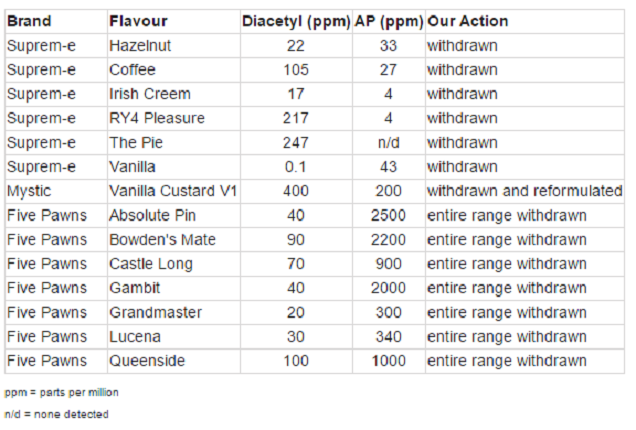
This seems very extreme, keeping in mind the recommendations of 65 μg per day (i.e. 1 ml of 65 ppm) for DA and 137 μg per day (1 ml of 137 ppm) for AP. Five Pawns’ GC-MS tests give the following results:
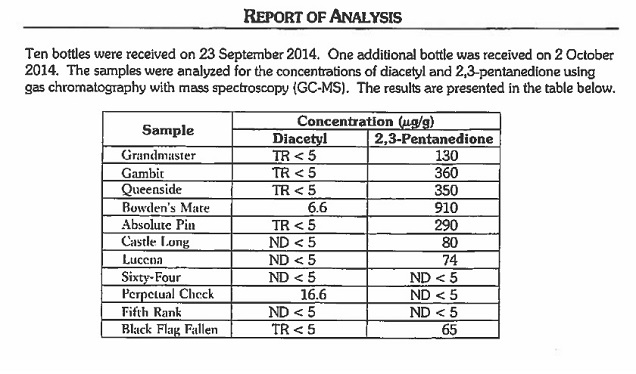
Again, a single ml of Gambit, Queenside, Bowden’s Mate or Absolute Pin will put you into the danger zone for AP exposure, and 1 ml of Grandmaster only falls short of the acceptable level by 7 μg. The GC-MS testing of Suicide Bunny’s juices showed that Sucker Punch and Mother’s Milk would also put you over the recommended intake within a single ml:
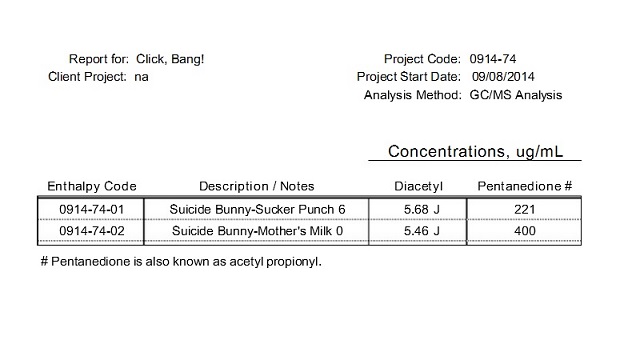
Since Vapor Shark also used Enthalpy and GC-MS for their tests, we can (tentatively, remembering the possible unreliability of these tests, and the fact that we haven't combed through all available tests) look at the worst offenders for DA and AP from these tests. For DA, the largest amounts detected (in μg/ml or ppm) appear to be in these juices:
- Comb the Desert by the Schwartz – 202
- The Downside by the Schwartz – 97.1
- The Upside by the Schwartz – 72.2
- FroYo! by Nick’s Blissful Brews – 56
- Apple Cider by Nick’s Blissful Brews – 48.3
- St. Valentine's Massacre by Vigilante Juice Co. – 38.5
- Dewberry Cream by Kilo – 34.8
- Vanilla Sky Tobacco by Hurricane Vapor – 25.2
- Cereal Milk by Kilo – 24.1
- Moon Sugar by Mr. Good Vape – 21.6
Of course, if the new Five Pawns tests are accurate, Queenside (100 μg/ml), Bowden’s Mate (90 μg/ml) and Castle Long (70 μg/ml) would be up there too, as would Mystic's Vanilla Custard and several from Suprem-e. In Dr. Farsalinos’ study, the highest amount found outside of a concentrated flavor was an astonishing 10,620 μg/ml, but since this wasn’t about naming and shaming (admirably, unlike what we’re doing here), we don’t know which juice it was.
For AP, the worst offenders found so far appear to be (in μg/ml or ppm):
- The Drifter by Vintage E-Liquids – 1,867
- #51 by Beard Co. – 1,843
- Indian Giver by Traditional Juice Co. –1,487
- Jazzy Boba by Jazzy Boba – 1,203
- Colossus by Cyclops Vapor – 1,042
- Rogue by Vigilante Juice Co. – 961
- Courage by Clouds of Hope – 914
- Bowden's Mate by Five Pawns – 910
- Dream Creme by Charlie's Chalk Dust – 904
- Hump Day by Vape 7 – 894
Again, the disputed Five Pawns tests would put Absolute Pin, Bowden’s Mate and Gambit at the top of the list. The highest result for AP in Dr. Farsalinos’ study was 1,018 μg/ml.
Keep in mind, though, that all tests could possibly be wrong, and of course, many of these companies could be reformulating their juices as a result of the results. Even though Five Pawns disputes the new results, they're reformulating their juices to address concerns, as a separate (and also PG-free) line.
Conclusion – A Bad Week for Five Pawns
Overall, Five Pawns hasn’t come out of this very well at all, and it’s underlined the fact that we need some standardization of tests, as well as some informed discussion of which testing methodology is the most appropriate for finding DA and AP in e-liquid. These discrepancies only cause confusion, and may be allowing Five Pawns, Suicide Bunny and others to sow misplaced doubt and falsely re-assure their customers. I don’t have the expertise to even suggest what the best approach is, but we clearly need one to prevent companies from hiding behind their own results whenever an unpleasant finding emerges.
The Electronic Cigarette Trade Association of Canada recommends high-performance liquid chromatography for DA and AP testing (and this was also used in Dr. Farsalinos’ study), but they say GC-MS is suitable given sufficiently low detection limits, and the Electronic Cigarette Industry Trade Association also uses GC-MS testing. AEMSA doesn’t appear to have specified, but since they’re friendly with Enthalpy, it seems like they’d back GC-MS too.
This discussion, however, misses the most depressing thing about this whole saga: DA and AP taste absolutely freaking amazing. Why are the delicious things always bad for you?

